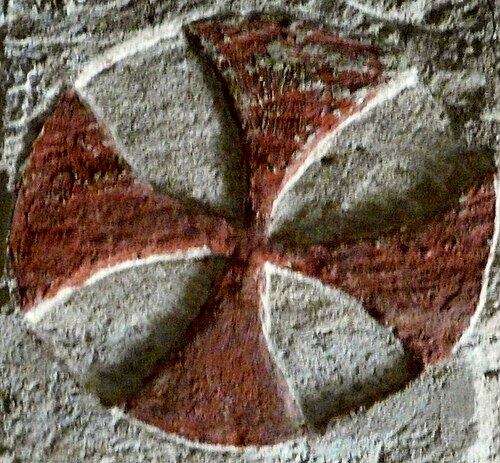

Consecration crosses arecrosses on the interior walls and exterior architecture of aChristianchurch orcathedral showing where thebishop has anointed the church withchrism orholy water in order toconsecrate it. There is often a place for acandle in front of each cross which is lit on the anniversary of the consecration. The crosses signify thesanctity of the church. The 13th-century Trinity Chapel inSalisbury Cathedral contains a painted consecration cross dating from 30 September 1225.[1][2]

Before the time of the reign ofConstantine between 306 and 337, the consecration of buildings to facilitatemass had to be private for fear of persecution, so physical consecration marks are unlikely to remain. There are various opinions as to the beginning of formal and public consecration of buildings. One version says that from Constantine's reign onward, a consecration was a public celebration to be commemorated in the following years, so that visual symbols of this event, such as writing theGreek andRoman alphabets on the church floor, became possible.[3] Another version creditsTheodosius I with starting the tradition between 379 and 395 by purifyingpagan temples during the transition of theRoman Empire to Christianity.[4]
Consecration "imprints an indelible mark (St Thomas, II-II:34:3) on the building by reason of which it may never be transferred tocommon orprofane uses." The physical mark of the consecration cross on the wall of a church signifies this.[3][5]

In the medieval tradition, the twelve interior crosses may be painted onplaster, or manufactured in an indestructible material and affixed to stone walls. The crosses tend to be placed high on the walls and to have a candlesconce fixed beneath. The twelve exterior crosses could be painted, engraved, carved or made of a different material and affixed.[3][5]
The most common and ancient form of four curved arms of equal length within a circle could easily be constructed by a stonemason using a compass. This shape is also called arounded cross.[4][6] Its shape is not unlike theBolnisi cross,cross pattée,iron cross andCanterbury cross. However the consecration cross exists in other traditional forms, such as thesun cross.[4]

Typically, there might be twelve painted crosses high on plaster walls within a church, and others engraved outside on door frames, pillars or corners. However this depends on the era, the form of Christianity, the ritual used, and the form of the building. Since the bishop sprinkles the altar and floor with holy water crosses also, it is not impossible that permanent commemorative marks may be placed there.[3][6][7] Some churches are very old and much changed, so in cases of good preservation one might find twelve crosses inside the earliest complete stone building, or a second set of twelve in a very large and reconsecrated rebuild where the new walls outsized the old.

TheSastamala Church inKarkku,Sastamala, has the restored remains of alimestone cross hanging on the wall. TheNaantali church inSouthwest Finland has eight painted crosses.
As of 1912Salisbury Cathedral had at least eight external crosses: three plain ones on the north wall, three on the east wall and two embossed ones on the south wall. Thesacristy on the south wall and the statuary on the west frontage probably concealed the remaining four crosses. The extant crosses were carved into the stone buttresses. There were interior painted crosses corresponding to the positions of the exterior crosses.[4][8] One of those Salisbury interior crosses commemorates the dedication of theTrinity Chapel on 30 September 1225.[1][2] The ruinedElgin Cathedral and theChurch of the Holy Rude in Stirling have crosses.[9] St Mary's church atOttery St Mary has various well-preserved crosses.[10] The Sacred Heart church atBushey was consecrated in 1977 byCardinal Hume, and contains twelve commemorative crosses which were donated by the localsocial club.[11] The church of St Peter and St Paul atAmpton contains a painted cross.[12]St Mary's Church, Shipton Solars, has medievalred-lead-painted crosses in the chancel and nave.[13] Interior crosses can be seen at All Saints church atKenton, St Mary, atThornham Parva and St Peter atGreat Livermere. St Peter's church atCreeting St Peter has exterior crosses.[6][14][15][16][17] There is one consecration cross in the nave of Dunfermline Abbey.